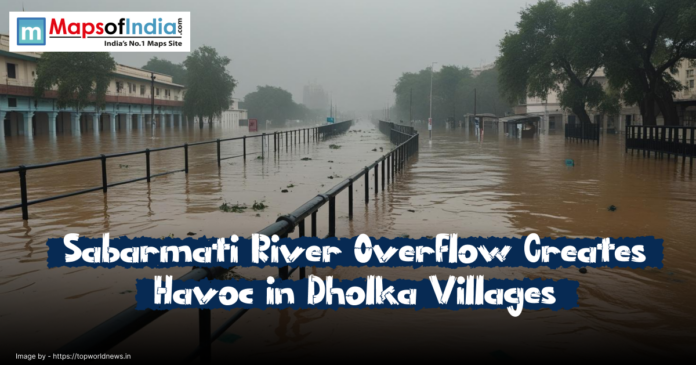The excessive rains in Gujarat have once again led to a flood-like scenario, this time in the villages of Dholka taluka, Ahmedabad district, where water of the Sabarmati river has flooded low-lying villages. The increase in the levels of water has broken natural barriers in various locations and left homes, farmlands and local roads flooded. The dramatic floods have caused havoc among the people, with some being displaced to find shelter elsewhere.
The Sabarmati river, which is already in flood because of constant rain in its catchment areas and because of water discharged by the reservoirs formed upstream, has already overstepped its usual boundaries. Subsequently, this has flooded villages along its banks in Dholka. People have complained of massive destruction of crops, especially in places where harvests were about to be harvested. The roads have also been washed away, thus affecting connectivity between villages, and people have been finding it hard to travel or get basic supplies.
Local governments have been scrambling to the struck villages to offer relief and safety to the people. Disaster management teams have started relocating families in flood-affected areas to temporary shelters. Foodstuffs, clean drinking water, and medical aid are being distributed to the displaced persons. People trapped in waterlogged regions are being rescued using tractors, boats and others.
The abrupt flooding has brought misery to the people in the village who are very reliant on agriculture to earn a living. Farmers worry that failure to recede water within a short time will further cost them in terms of the loss of standing crops. Absence of long-term flood control measures has also been a concern to many residents. Locals stated that the issue of flooding is nearly an annual occurrence when strong rains are experienced, although long-lasting measures to address the problem, like reinforced embankments and better drainage systems, have not been put in place.
Authorities are on the case and maintaining a check on water discharge by the upstream reservoirs of the Sabarmati. Authorities have promised the citizens that the relief and rebuilding efforts will go on until the situation is completely contained. Nevertheless, in Gujarat, the rains will persist in some areas, thus posing the risk of additional waterlogging.
The disaster in Dholka shows why there is a pressing need to control floods in the flood-prone areas of the state. Until permanent action is initiated, the villages/areas along the Sabarmati river will continue to face vulnerability to such tragedies all the time, leaving the people anxious during every monsoon.










